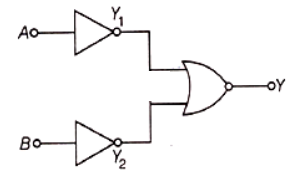In the combination of the following gates, the output Y can be written in terms of inputs A and B as :-
1.
2.
3.
4.
In the circuit shown in the figure, the input voltage Vi is 20 V, VBE = 0, and VCE = 0. The values of IB, IC and are given by:
1.
2.
3.
4.
In a common-emitter transistor amplifier, the audio signal voltage across the collector is 3V. The resistance of the collector is 3k. If current gain is 100 and the base resistance is 2k, the voltage and power gain of the amplifier is:
1. 15 and 200
2. 150 and 15000
3. 20 and 2000
4. 200 and 1000
4. AND gate
The given circuit has two ideal diodes connected as shown in the figure below. The current flowing through the resistance \(R_1\) will be:

| 1. | \(2.5~\text A\) | 2. | \(10.0~\text A\) |
| 3. | \(1.43~\text A\) | 4. | \(3.13~\text A\) |

To unlock all the explanations of 14 chapters you need to be enrolled in MasterClass Course.

To unlock all the explanations of 14 chapters you need to be enrolled in MasterClass Course.
What is the output Y in the following circuit, when all the three inputs A, B, C are first 0 and then 1?

1. 0, 1
2. 0, 0
3. 1, 0
4. 1, 1

To unlock all the explanations of 14 chapters you need to be enrolled in MasterClass Course.

To unlock all the explanations of 14 chapters you need to be enrolled in MasterClass Course.

2. A = 1, B = 1, C = 0
3. A = 1, B = 0, C = 1
4. A = 0, B = 1, C = 0

To unlock all the explanations of 14 chapters you need to be enrolled in MasterClass Course.

To unlock all the explanations of 14 chapters you need to be enrolled in MasterClass Course.
2. 10-1A
3. 10-3A
4. 0A

To unlock all the explanations of 14 chapters you need to be enrolled in MasterClass Course.

To unlock all the explanations of 14 chapters you need to be enrolled in MasterClass Course.

2. NAND
3. AND
4. NOR

To unlock all the explanations of 14 chapters you need to be enrolled in MasterClass Course.

To unlock all the explanations of 14 chapters you need to be enrolled in MasterClass Course.











